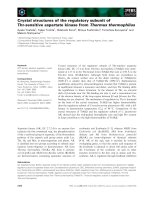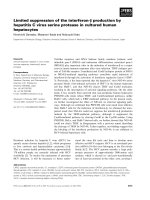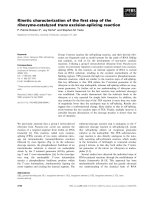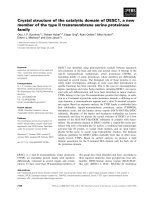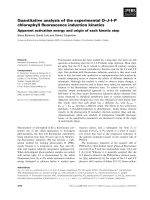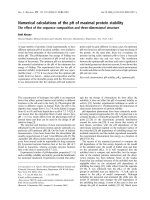báo cáo khoa học: " Stable relocation of the radial head without annular ligament reconstruction using the Ilizarov technique to treat neglected Monteggia fracture: two case reports" doc
Bạn đang xem bản rút gọn của tài liệu. Xem và tải ngay bản đầy đủ của tài liệu tại đây (1.24 MB, 6 trang )
CAS E REP O R T Open Access
Stable relocation of the radial head without
annular ligament reconstruction using the Ilizarov
technique to treat neglected Monteggia fracture:
two case reports
Altaf A Kawoosa
*
, Shabir A Dhar, Mohammed Farooq Butt, Shareef A Wani, M R Mir, T A Dar
Abstract
Introduction: A Monteggia facture dislocation is not an uncommon injury, and the diagnosis can often be missed.
Long-term follow-up of untreated Monteggia fracture dislocations reveals development of premature arthritis, pain,
instability, and loss of pronation and supination. Methods involving annular ligament reconstruction require post-
operative immobilization and use of transcapitellar pinning for maintenance of reduction, and thus a delay in
rehabilitation. The literature reports satisfactory results with methods that involve ulnar osteotomy and open
reduction of the radial head without annular ligament reconstruction. We used the Ilizarov method in two cases
with neglected Monteggia fracture dislo cations to stably reduce the radial head without open reduction and
annular ligament reconstruction.
Case presentation: We report two cases of neglected Monteggia fracture dislocation, in two Kashmiri boys aged
four and six years. Using ulnar osteotomy with distraction osteogenesis, we were able to relocate the radial head
gradually and maintain the reduction without a requirement for open reduction and annular ligament
reconstruction.
Conclusion: Distraction lengthening and hyperangulation in different planes by use of the Ilizarov technique
effectively reduces the radial head without open reduction and annular ligament reconstruction.
Introduction
Giovanni Battista Monteggia first described in 1814 the
fracture dislocation now named after him. It represents
a link between injuries of the forearm and the elbow [1].
These injuries follow the course of forearm fractures
prognostically if recognized and t reated early. However
these injuries are often missed at the time of initial
trauma [2,3].
Long-term follow-up of untreated Monteggia fracture
dislocations reveals development of premature arthritis,
pain, instability, and loss of pronation and supination
[4,5]. Thus, it is imperative to treat the neglected fracture
as soon as it is diagnosed. Freedman et al. performed
reconstructive procedures up to six years after injury [6].
Currently, chronic dislocations are treated by ulnar
osteotomy, open reduction of the radial head and recon-
struction of the annular ligament [7]. The literature
reports excellent results [8,9], but with restricted move-
ment [10,11] and development of complications [12]
ass ociated with methods involving open reduction of the
radial head, and ulnar ostoetomy with or without annular
ligame nt reconstruction. Hirayama et al., considering the
interosseous membrane as the stabilizer of the radial
head, described reduction of the radial head by hyperan-
gulation and lengthening of the ulna without reconstruc-
tion of the annular ligament [13]. Relocation of the radial
head has been successfully achieved by using distraction
lengthening and hyperangulation over a uniplanar
lengthening device [14].
To create hyperanglation in two planes, we used the Ili-
zarov method in two cases with neglected Monteggia frac-
ture dislo cations. Using ulnar osteotomy with distraction
* Correspondence:
Department of Orthopaedics, Government Medical College, Srinagar, Jammu
and Kashmir, India
Kawoosa et al. Journal of Medical Case Reports 2010, 4:344
/>JOURNAL OF MEDICAL
CASE REPORTS
© 2010 Kawoosa et al; licensee BioMed Central Ltd. This is an Open Access article distributed under the terms of the Creative
Commons Attribution License ( whi ch permits unrestricted use, distribution, and
reproduction in any medium, provided the original work is properly cited.
osteogenesis, we were able to relocate the radial head gra-
dually. Our follow-up supports the view that distraction
lengthening and hyperang ulation in different planes may
obviate the need for open reduction and annular ligament
reconstruction.
Case presentation
Our first patien t was a four-year-old Kashmiri boy, who
had pain and deformity of the right elbow. The child
had received trauma to the elbow six months previously.
On physical examination , a p rominent radial head and
mild limitation of supination and pronation were seen.
Our second patient was a six-year -old Kashmiri boy. He
had a history of elbow trauma one year previously, for
which he had not received any treatment at the time.
In both cases, an anter olateral dislocation of the radial
head was confirmed by radiography. An underlying
ulnar injury in both our cases was suspected because of
the loss of proximal convexity of ulna (Figure 1).We
chose a procedure (the Ilizarov technique) that would
produce controlled lengthening and hyperangulation in
two planes to restore the radiocapitellar articulation
without open reduction and reconstruction of annular
ligament. The procedure was explained to both sets of
parents and written informed consent obtained from
them. Approval from the institutional ethics board was
also obtained.
Radio graphs in both anterio-posterior and lateral view
were studied to assess the dislocation of the radial head.
Because the dislocation in both of our patients was an
anterolateral one (Figures 1, 2), an osteotomy in the
proximal ulna and differential lengthening in two planes
was planned to create a medial (Figure 3) and posterior
(Figure 4) hyperangulation, to place the radial head in
the appropriate radiocapitellar orientation. We hoped to
avoid open reduction of the dislocation and reconstruc-
tion of the annular ligament.
The surgery was undertaken under general anesthesia.
A two-ring construct with hinge application was used.
The ring was fixed only to the ulna, to allow free supi-
nation and pronat ion movement. The proximal ring was
fixed with an Ilizarov wire and one half-pin. The distal
ring was fixed by two half-pins in different planes on
the subcutaneous border. Through an incision 15 mm
long, a low-energy corticotomy of the ulna was per-
formed at the proposed site (Figure 5). We did not
make any attempt to hyperangulate the ostotomy intrao-
peratively. Distraction was started on the seventh day
Figure 1 Preoperative radiograph of patient 1 showing
Monteggia fracture dislocation (Patient 1).
Figure 2 Preoperative radiograph showing radial head
dislocation (Patient 2).
Kawoosa et al. Journal of Medical Case Reports 2010, 4:344
/>Page 2 of 6
after surgery in a differential manner, to create length-
ening and hyperangulation in two planes as planned.
We followed up the progress of our patients every
week with both clinical and radiologic examinations to
assess the lengthening, angulation and relocation of the
radial head. For our first patient, relocation of the radial
head was confirmed both clinically and by radiography
by the third postoperative week. Relocation took longer
for our second patient, being achieved by the fifth post-
operative week and involving lengthening of the ulna by
15 mm (Figure 6). Both patients were encouraged to
perform range of motion exercises of the elbow, and the
frame was left in place until maturation of the regener-
ated bone. The ring was finally taken off at six weeks
forourfirstpatientandat12weeksforoursecond
patient; for both, a protectiv e long arm cast was applied
for another two weeks. The regenerated bone healed at
an average rate of three weeks/cm. The radial head
maintained the reduced position without annular liga-
ment reconstruction (Figures 7, 8).
At follow-up two years after surgery, both patients had
an excellent result a nd 100% range of motion around
the affected elbow (Figures 9, 10).
Figure 3 Sketch showing planning for reduction of the radial
head with hyperangulation of the regenerate in the anterior-
posterior planes.
Figure 4 Sketch showing planning for reduction of the radial
head with hyperangulation of the regenerate in lateral planes.
Figure 5 Postoperative radiograph after application of Ilizarov
fixator and ulnar osteotomy (Patient 1).
Kawoosa et al. Journal of Medical Case Reports 2010, 4:344
/>Page 3 of 6
Discussion
Owing to the potential complications of conservative
methods in cases of neglected Monteggia injuries, it is
important that the radial head be replaced in appropri-
ate relation to the capitellum. This is especially true in
children who are less than 12 years of age.
In procedures involving reconstruction around the
radial head, it is mandatory to stabilize the radial head
by a transcapitel lar K wire to prevent redislocation [4,7].
In one study, Hori et al. reported that of the 13 patients
treated surgically with open reduction, ulnar osteotomy
and annular ligament reconstruction, there w ere seven
re-dislocations, and seven patients had restriction of
movement [15]. The authors reported that they achieved
better results once they modified the osteotomy proce-
dure, and stressed the need for angulation and elonga-
tion of the osteotomy. Rodgers et al. reported 14
complications in seven patients, including problems
with the osteotomy site, re-dislocations and nerve inju-
ries [12].
Restriction of movement has been seen frequently in
procedu res involving radial head reconstruction [10 ,11].
Problems with the f ixation of the osteotom y are not
uncommon [13]. Hasler found it easy to reconstruct the
radiocapitellar joint, and to allow early resumption of
functional exercises by using external fixation for the
ulnar osteotomy with no annular ligament reconstruc-
tion [16]. Freedman et al. used a technique in which the
annular ligament was not reconstructed but the radial
notch was deepened to achieve stability [6].
Chronic dislocations may be associated with signifi-
cant discrepancy in the radioulnar length, the radius
having overgrown as a result of lack of support between
the capitellum and the radial head. The optimum treat-
ment in these patients is lengthening of the osteotomy
in addition to angulation. The e xcellent results of a
lengthening osteotomy are best reflected in the cases
presented by Exner, who used distraction lengthening
over a uniplanar lengthening device to create hyperan-
gulation and lengthening to reduce the radial head [14].
However, the process of hyperangulation was performed
after distraction at subsequent stages under analgesia.
We found the Ilizarov technique to be advantageous in
other respects as wel l, as it allows lengthening a nd
angulation in several planes, and the processes of
lengthening and angulation proceed simultaneously.
Figure 6 Postoperative radiograph during disraction
lengthening (Patient 2).
Figure 7 Radiograph taken at the two-year follow-up visit
showng excellent relocation of the radial head (Patient 1).
Kawoosa et al. Journal of Medical Case Reports 2010, 4:344
/>Page 4 of 6
The advantages of distraction treatment can be sum-
marized as: minimally invasive surgery, controll ed
lengthening, no radiocapitellar intervention, no need for
bone grafting, and early resumption of functional exer-
cises. The only difficulty encountered during the process
of correction in our patients was the radiologic interpre-
tation of the relocation of the radial head, because of
the superimposing proximal steel ring; however, this
problem can be easily managed by the use of carbon
fiber radiolucent rings.
Conclusion
Use of ulnar osteotomy with distraction lengthening and
hyperangulation in several planes with the Ilizarov tech-
nique could be an effective method of treating neglected
Monteggia fracture dislocations.
Consent
Written informed consent was obtained from the par-
ents of both the patients for publication of this case
report and accompanying images. A copy of the written
consent is available for the review by the Editor in Chief
of this journal.
Acknowledgements
The authors declare that no funding was obtained for the writing and
submission of the manuscript.
Authors’ contributions
AAK was responsible for the concept, planning, surgery and manuscript
preparation. The rest of the authors contributed in preparation of the
manuscript. All authors have read and approved the final manuscript.
Competing interests
All authors confirm that there are no conflicts of interests, including financial
and personal relationships with other people, or organizations, that could
inappropriately influence (bias) their work.
Received: 19 September 2009 Accepted: 26 October 2010
Published: 26 October 2010
References
1. Monteggia GB: Instituzioni Chirurgiche Milan, Maspero; 1814.
Figure 8 Radiograph taken at the final follow-up visit showing
relocation of the radial head (Patient 2).
Figure 9 Supination at elbow.
Figure 10 Pronation at elbow.
Kawoosa et al. Journal of Medical Case Reports 2010, 4:344
/>Page 5 of 6
2. Dormans JP, Rang M: The problem of Monteggia fracture dislocation in
children. Orthop Clin North Am 1990, 21:251-256.
3. Fowles JV, Sliman N, Kassab MT: Monteggia lesion in children: fracture of
the ulna and dislocation of the radial head. J Bone Joint Surg Am 1983,
65:1276-1282.
4. Bell-Tawse AJS: The treatment of malunited anterior monteggia fractures
in children. JBJS 1965, 47B:718-723.
5. Kalamchi A: Monteggia fracture dislocation in children. JBJS 1986, 68-
A:615-619.
6. Freedman L, Luk K, Leong JC: Radial head reduction after missed
monteggia fracture; Brief report. JBJS 1988, 70;B:846-847.
7. LIoyd Roberts GC, Bucknill TM: Anterior dislocation of the radial head in
children: Aetiology, natural history and management. J Bone Joint Surg
(Br) 1977, 58-B:402-407.
8. Degreef I, Desmet L: Missed radial head dislocationin children associated
with ulnar deformity; treatment by open reduction and ulnar
osteotomy. J Orthop Trauma 2004, 18:375-378.
9. Wang Mn, Chang Wn: Chronic post traumatic anterior dislocation of the
radial head in children; thirteen cases treated by open reduction, ulnar
osteotomy and annular ligament reconstruction through Boyd incision. J
Orthop Trauma 2006, 20:1-5.
10. Devnani AS: Missed Monteggia fracture dislocation in children. Injury
28:131-133.
11. Stoll TM, Willis RB, Paterson DC: Treatment of missed Monteggia fracture
in the child. J Bone Joint Surg Br 1992, 74:436-440.
12. Rodgers WB, Waters PM, Hall JE: Chronic Monteggia lesions in children:
complications and results of reconstruction. J Bone Joint Surg Am 1996,
78:1322-1329.
13. Hirayama T, Takimitsu Y, Yagihara K, Mikita A: Operation for chronic
dislocation of the radial head in children; reduction by osteotomy of the
ulna. J Bone joint Sur (Br) 1987, 69-B:639-642.
14. Exner GU: Missed chronic anterior Monteggia lesion; Closed reduction by
gradual lengthening and angulation of the ulna. J Bone Joint Surg (BR)
2001, 83-B:547-550.
15. Horii E, Nakamura R, Koh S, Inagaki H, Yajima H, Nakao E: Surgical
treatment for chronic radial head dislocation. J Bone joint Surg Am 2002,
84-A:1183-1188.
16. Hasler CC, Von Laer L, Hell AK: Open reduction, ulnar ostoetomy and
external fixation for chronic anterior dislocation of the head of radius. J
Bone Joint Surg [Br] 2005, 78:88-94.
doi:10.1186/1752-1947-4-344
Cite this article as: Kawoosa et al.: Stable relocation of the radial head
without annular ligament reconstruction using the Ilizarov technique to
treat neglected Monteggia fracture: two case reports. Journal of Medical
Case Reports 2010 4:344.
Submit your next manuscript to BioMed Central
and take full advantage of:
• Convenient online submission
• Thorough peer review
• No space constraints or color figure charges
• Immediate publication on acceptance
• Inclusion in PubMed, CAS, Scopus and Google Scholar
• Research which is freely available for redistribution
Submit your manuscript at
www.biomedcentral.com/submit
Kawoosa et al. Journal of Medical Case Reports 2010, 4:344
/>Page 6 of 6


